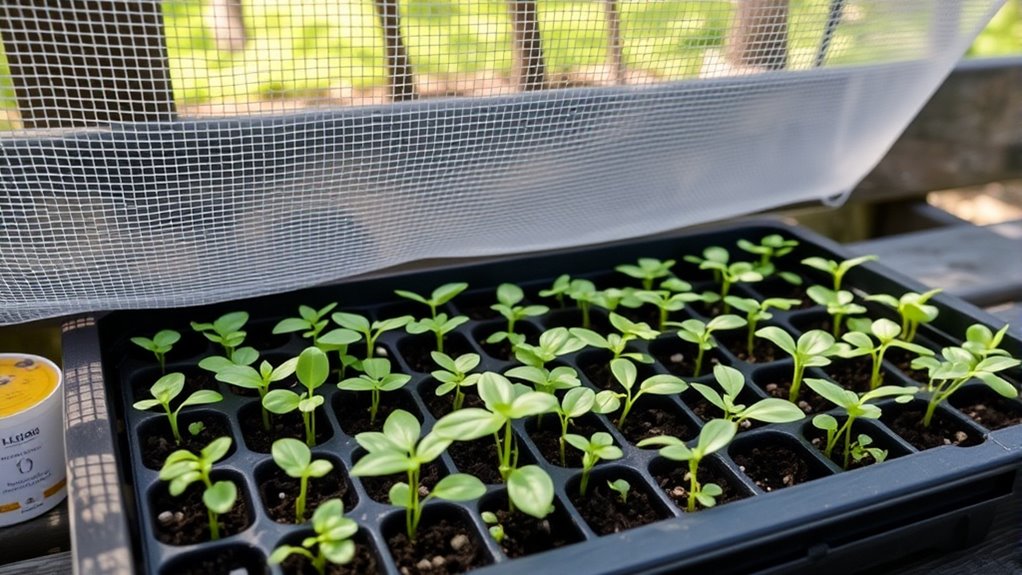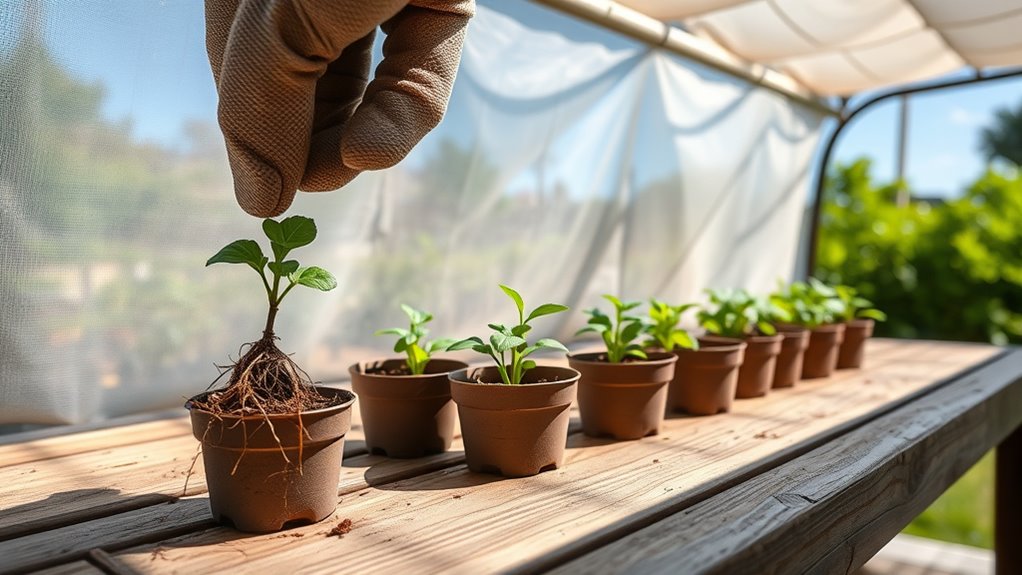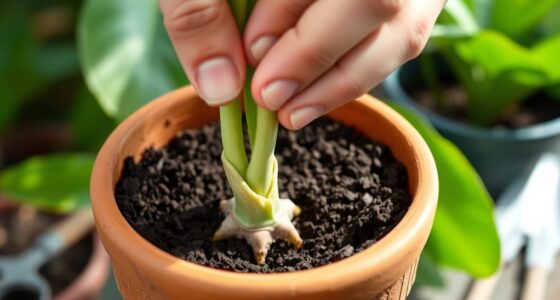To harden off seedlings, start by placing them in sheltered outdoor spots like porches or covered patios, gradually increasing their exposure to sunlight and wind over a week. Begin with a few hours each day in shade, then slowly extend outdoor time and sunlight exposure, making sure nighttime temperatures stay above 50°F. Protect plants from harsh conditions and monitor for stress signs. Keep going, and you’ll discover how to guarantee your seedlings are strong and ready for the garden.
Key Takeaways
- Gradually introduce seedlings to outdoor conditions starting with a few hours in sheltered, shaded areas.
- Increase outdoor exposure and sunlight gradually over a week, monitoring for stress signs.
- Ensure nighttime temperatures stay above 50°F before leaving seedlings outside overnight.
- Protect young plants from harsh weather using row covers or cloches during cold or windy days.
- Continue hardening for at least a week, developing sturdy stems and healthy roots before transplanting outdoors.

When your seedlings have grown strong enough indoors, it’s time to harden them off before planting them outside. This process is essential for indoor acclimatization, helping your plants adjust gradually to the harsher outdoor environment. Without proper outdoor adaptation, seedlings can suffer from sunburn, wind damage, or shock, which can stunt their growth or even kill them. The goal is to ease them into outdoor conditions slowly, so they develop the resilience needed to thrive once planted in your garden.
Start by placing your seedlings outside in a sheltered spot, like a porch or covered patio, for a few hours each day. Keep them in a shaded area initially to prevent direct sunlight from scorching their tender leaves. This gradual exposure allows them to adapt to the increased light, wind, and temperature fluctuations outside. Over several days, extend the time they spend outdoors and increase their exposure to direct sunlight, but always watch for signs of stress like wilting or leaf scorch. If you notice these, bring them back inside for a bit longer before trying again.
Temperature plays a pivotal role in outdoor adaptation. Make sure nighttime temperatures stay above 50°F (10°C) before leaving your seedlings outside overnight. If early spring or late fall temperatures are still too cold, wait until conditions stabilize. Sudden cold snaps can damage or kill your young plants. When the weather is consistently mild, you can leave your seedlings outdoors overnight, but continue to monitor weather forecasts for unexpected cold or wind storms. Protect your plants with row covers or cloches if necessary, especially during sudden temperature drops. Additionally, understanding plant hardiness zones can help determine the best timing for outdoor planting based on your local climate.
As your seedlings become more accustomed to outdoor conditions, you can gradually increase their exposure to wind and direct sunlight. This step-by-step approach strengthens their stems and prepares them for their permanent spot in your garden. Keep an eye on soil moisture, as outdoor conditions often cause faster drying. Water your seedlings thoroughly before each outdoor session, ensuring they’re not stressed from drought. Remember, patience is key—rushing this process can undo the benefits of hardening off and set back their growth.
Consistency is essential during this period. Stick to a schedule, and don’t skip steps, even if the weather seems ideal. Proper outdoor adaptation ensures your seedlings develop sturdy stems, healthy leaves, and a robust root system. When they’ve successfully endured the outdoor conditions for a week or more, you can confidently transplant them into your garden, knowing they’re ready to flourish in their new environment.
Frequently Asked Questions
How Long Should I Harden off Seedlings Each Day?
You should harden off seedlings gradually over about 7 to 10 days, starting with 1-2 hours each day. During plant acclimation, increase exposure by 1-2 hours daily, ensuring they experience outdoor temperature regulation without stress. Monitor weather conditions closely, especially wind and direct sunlight, and bring seedlings back inside if they show signs of stress. This slow process helps them adapt safely to outdoor conditions.
Can I Harden off Seedlings Outdoors Overnight?
Yes, you can harden off seedlings outdoors overnight, but do it gradually to prevent seedling diseases and minimize transplant shock. Start by exposing them for a few hours during the day, then extend the time gradually. When you leave them outside overnight, make certain the weather isn’t too cold or damp. Keep an eye on the seedlings, and bring them back inside if they show signs of stress or damage.
What Signs Indicate Seedlings Are Ready for Full Outdoor Exposure?
You’ll know your seedlings are ready for full outdoor exposure when their seedling health shows strong, vibrant growth with sturdy stems and healthy leaves. They should tolerate gentle outdoor conditions without wilting or showing signs of stress. Gradually increase outdoor exposure over several days, monitoring their response. If they remain vigorous and adapt well, they’re outdoor-ready. Trust your observations, and avoid rushing to prevent setbacks in their development.
Does Hardening off Work for All Types of Seedlings?
You can’t paint all seedlings with the same brush—harden off varies by seedling varieties. Some, like tomatoes, adapt well to outdoor conditions, while others, like delicate herbs, need extra care. It’s a balancing act, as indoor vs outdoor exposure can be a game-changer. The process works for most, but knowing your seedlings’ needs helps prevent shock. Think of it as a gentle wake-up call, not a jarring jolt.
How Do I Protect Seedlings From Harsh Weather During Hardening?
To protect your seedlings from harsh weather during hardening, use shade cloth to shield them from intense sun and reduce heat stress. Set up windbreaks, like fencing or rows of plants, to block strong winds that can damage tender stems. Keep an eye on weather forecasts, and bring seedlings indoors or into sheltered areas during storms or extreme conditions. This approach helps your seedlings adapt gradually and stay healthy.
Conclusion
As you gently ease your seedlings into the world, think of nature’s tender embrace guiding them to strength. With patience and care, you’re helping them bloom into resilient plants, ready to face the sun’s warm kiss and gentle breezes. Trust this gradual journey; it’s like coaxing a delicate songbird into singing louder. Soon, your garden will stand proud, a vibrant tapestry woven from your nurturing touch and the quiet promise of growth.









